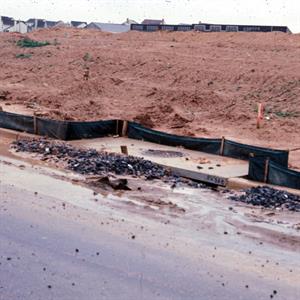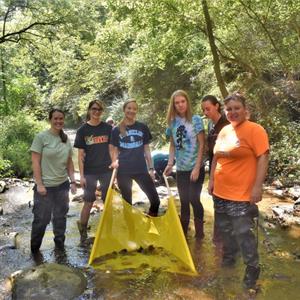By Heather Black, IWLA Chesapeake Conservation Corps volunteer
 I have spent the majority of my life in highly urbanized environments. As a child, I never considered the impact development could have on nearby waterways. But I can remember the occasional news story about residents concerned that a new shopping center or highway would damage their local stream. Without steps to minimize impact, odds are that it did. But how can we know for sure?
I have spent the majority of my life in highly urbanized environments. As a child, I never considered the impact development could have on nearby waterways. But I can remember the occasional news story about residents concerned that a new shopping center or highway would damage their local stream. Without steps to minimize impact, odds are that it did. But how can we know for sure?
The answer is “baseline data.” A baseline is a starting point for making comparisons. Baseline data on water quality helps us track changes in stream health over time. Essentially, you can’t know if water quality has changed – for better or worse – without a starting point. It’s especially important to establish a baseline before major changes takes place in your community, such as a new construction project or pipeline installation.
Establishing a baseline does not mean monitoring a site once. We continue to monitor the same location – multiple times each year or each month, depending on what we’re monitoring for – to create a baseline reading. This information is critical to tracking the impact of new development in areas around a stream.
Here at the Izaak Walton League headquarters, the baseline readings we collected for chloride levels on Muddy Branch stream over the past several years allowed us to identify chloride spikes during the winter months due to road salts. Without the baseline data, we would not have known chloride levels were significantly higher than during the rest of the year.
There are several million miles of rivers and streams across the United States, and it is impossible for state and federal government agencies to test all of these waterways – especially the smallest (and most vulnerable) ones. That’s where community volunteers come in. Volunteering to monitor water quality not only provides an opportunity to learn new skills and get outside, it also gives us a better and deeper understanding of issues that can affect the health of local streams and rivers. Volunteers have an advantage over state and federal agencies: we can visit the same site multiple times a year, which is important in tracking changes to water quality.
 Spring is the perfect time to start monitoring your local streams. The Izaak Walton League offers several training programs and protocols to fit your needs and water quality concerns. Check our Water Workshops web page for upcoming trainings or take the first steps yourself using the resources on our Save Our Streams web page.
Spring is the perfect time to start monitoring your local streams. The Izaak Walton League offers several training programs and protocols to fit your needs and water quality concerns. Check our Water Workshops web page for upcoming trainings or take the first steps yourself using the resources on our Save Our Streams web page.
If some type of development does occur, don’t stop monitoring! Continue checking water quality at the same site (if it is still safe to get to and you still have permission). Comparing before-and-after data will show just how big an impact the development had on the environment – and could even affect future construction projects.
It is never too late to start defending our streams!